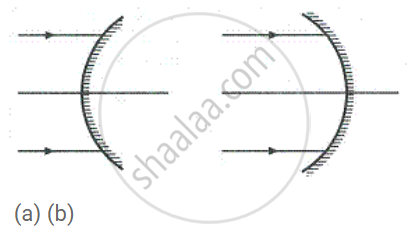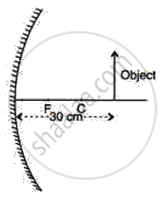Advertisements
Advertisements
प्रश्न
A small object is placed 150 mm away from a diverging lens of focal length 100 mm.
(i) Copy the figure below and draw rays to show how an image is formed by the lens.
Figure
(ii) Calculate the distance of the image from the lens by using the lens formula.
उत्तर
The image formed by the lens is virtual, erect and diminished in size.

(a)(ii) Object distance (u) = -150 mm = -15 cm (sign convention)
Focal length (f) = -100 mm = -10 cm (sign convention)
Image distance (v) = ?
Applying the lens formula, we have:
`1/v-1/u=1/f`
`1/v-1/-15=1/-10`
`1/v+1/15=-1/10`
`1/v=1/10-1/15`
`1/v=(-3-2)/30`
`1/v=(-5)/30`
`v=-6 cm `
APPEARS IN
संबंधित प्रश्न
A simple microscope is used by watch repairers. Give reason.
What type of image is formed:
in a plane mirror?
In each case (a) and (b), draw reflected rays for the given incident rays and mark focus by the symbol F.

Name the kind of mirror used to obtain:
A virtual and enlarged image
How is the focal length of a spherical mirror related to its radius of curvature?
Upto what maximum distance from a concave mirror, the image can be obtained? What will be the location of object for it?
A straight stick partly dipped in water obliquely, appears to be bent at the surface of water.
What do you understand by the term real image?
An object is placed in front of a concave mirror as shown in the following figure. By scale drawing, find the nature of the image. Given f = 10 cm, v = 30 cm.

In torches, search lights and headlights of vehicles the bulb is placed ______.
